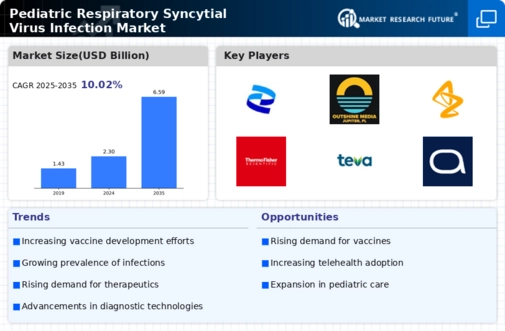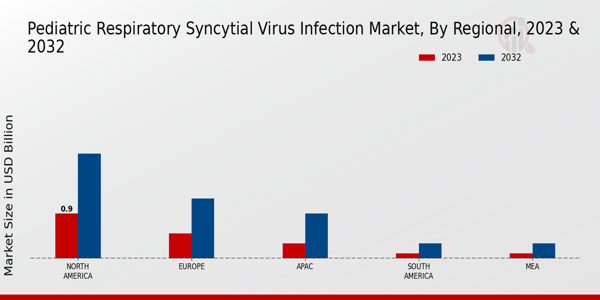Market Growth Projections
The Global Pediatric Respiratory Syncytial Virus Infection Market Industry is projected to experience substantial growth, with estimates indicating an increase from 2.3 USD Billion in 2024 to 6.59 USD Billion by 2035. This growth trajectory suggests a compound annual growth rate of 10.04% from 2025 to 2035. Such projections highlight the increasing recognition of RSV as a critical public health issue, prompting investments in research, development, and healthcare infrastructure. As the market evolves, stakeholders are likely to focus on innovative therapies and preventive strategies to address the challenges posed by RSV, further driving market expansion.
Growing Awareness and Education
There is a growing awareness and education regarding RSV among parents and healthcare professionals, which is influencing the Global Pediatric Respiratory Syncytial Virus Infection Market Industry. Campaigns aimed at educating caregivers about the symptoms and risks associated with RSV are becoming more prevalent. This increased awareness is likely to lead to earlier diagnosis and treatment, ultimately improving patient outcomes. As more individuals understand the importance of preventive measures, such as vaccination and hygiene practices, the demand for RSV-related healthcare services is expected to rise. This shift in awareness may contribute to the overall growth of the market.
Increased Healthcare Expenditure
The Global Pediatric Respiratory Syncytial Virus Infection Market Industry is benefiting from increased healthcare expenditure across various regions. Governments and health organizations are allocating more resources to combat respiratory infections, including RSV. This trend is particularly evident in developed countries, where healthcare budgets are expanding to improve pediatric care. Enhanced funding facilitates the development of new treatments and preventive measures, which could lead to better management of RSV infections. As healthcare systems prioritize respiratory health, the market is expected to experience significant growth, driven by the demand for innovative solutions to address the challenges posed by RSV.
Rising Incidence of RSV Infections
The Global Pediatric Respiratory Syncytial Virus Infection Market Industry is witnessing a notable increase in the incidence of RSV infections among infants and young children. Data indicates that RSV is responsible for a significant proportion of hospitalizations in this demographic, with estimates suggesting that around 1 in 2 children will contract the virus by the age of two. This rising incidence is driving demand for effective treatment options and preventive measures, contributing to the market's growth. As awareness of RSV's impact on pediatric health increases, healthcare providers are more likely to invest in innovative therapies, thereby expanding the market's potential.
Advancements in Therapeutic Options
Innovations in therapeutic options for RSV are shaping the Global Pediatric Respiratory Syncytial Virus Infection Market Industry. Recent developments in monoclonal antibodies and antiviral medications have shown promise in reducing the severity of RSV infections. For instance, the introduction of palivizumab has been pivotal in preventing severe RSV disease in high-risk infants. As these advancements continue, they are likely to enhance treatment efficacy and patient outcomes, thereby attracting more investment in research and development. The market is projected to grow from 2.3 USD Billion in 2024 to 6.59 USD Billion by 2035, reflecting a compound annual growth rate of 10.04% from 2025 to 2035.
Emerging Markets and Demographic Shifts
Emerging markets are playing a crucial role in the expansion of the Global Pediatric Respiratory Syncytial Virus Infection Market Industry. Countries with rapidly growing populations and improving healthcare infrastructure are witnessing an increase in RSV cases. As urbanization progresses and healthcare access improves, the demand for RSV treatments and preventive measures is likely to rise. Additionally, demographic shifts, such as an increase in the number of children under five, further amplify the need for effective RSV management. This trend presents significant opportunities for market players to introduce innovative solutions tailored to the specific needs of these regions.












